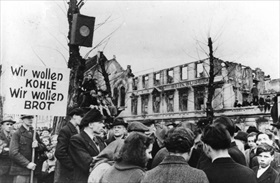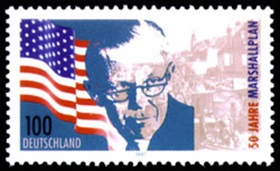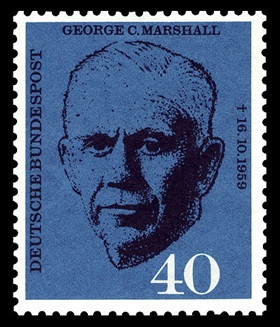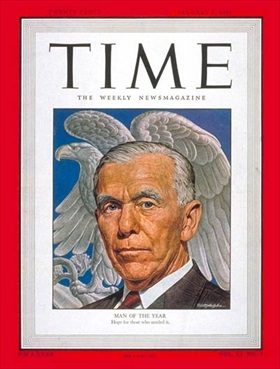PUNITIVE PEACE PLAN IMPOSED ON GERMANY
Washington, D.C. • May 10, 1945
On this date in 1945 President Harry S. Truman signed the Joint Chiefs of Staff Directive 1067. The person behind the directive was Henry Morgenthau, Jr., President Franklin D. Roosevelt’s former Treasury Secretary who had long advocated that postwar German occupation include measures to eliminate Germany’s ability to wage war for a third time—the first two times being the First and Second World Wars. JCS 1067 applied only to the U.S. zone of occupation, not the British, Soviet, and later French zones. Truman did, however, succeed in incorporating much of JCS 1067 (and its inspiration, the 1944 Morgenthau Plan) into the Potsdam Agreement, a “communiqué” that the victorious powers hashed out during their meeting in a Berlin suburb between July 17 and August 2, 1945.
Under the Potsdam provisions, U.S. occupation efforts focused mainly on denazification, German disarmament and demilitarization, the prosecution of German war criminals, and the reduction or destruction of all civilian heavy industry that might have a military potential. Production of locomotives, merchant ships, and aircraft, for instance, was prohibited and banks were restricted in their lending. What was left of the German economy was to be restructured toward light industry and agriculture in accordance with Germany’s “approved peacetime needs.” For example, steel production was to be capped at 25 percent of prewar production, and car production to 10 percent of prewar levels. Coal, coke, electrical equipment, leather goods, alcohol, toys, musical instruments, textiles, and clothing were to take the place of the heavy industrial products that had formed most of Germany’s prewar exports.
Following the Agreement’s implementation, German living standards declined and malnutrition and death rates rose above prewar levels. To prevent mass starvation the Americans and British were increasingly forced to import foodstuffs to the tune of $1.5 billion by 1948, which was paid for by Germany. (In 1946–1947 the average daily caloric intake was estimated to be 1,080, which was far below recommended minimum nutrition levels.) Beginning in mid-1946 many observers came to see the Morgenthau Plan and JCS 1067 as inflicting undue hardship on Germans and limiting the ability of their country to recover from the devastating effects of the past dozen years now compounded by the resettlement in the Allied occupation zones of enormous numbers of ethnic Germans (12–14 million by 1950) expelled from Poland, Czechoslovakia, Hungary, Romania, and the Soviet Union. Truman’s Secretary of State, retired Gen. George C. Marshall, citing national (i.e., U.S.) security concerns following an eye-opening fact-finding visit to Western Europe, was able to convince the president to rescind the punitive occupation directive JCS 1067 in 1947, months after the Morgenthau Plan had been abandoned as official U.S. policy by Marshall’s predecessor at the State Department.
In April 1948 a new Economic Recovery Program was in place, informally named after Marshall. The $13 billion, four-year Marshall Plan helped European economies (apart from those of the Soviet satellites trapped behind the Iron Curtain) quickly recover and modernize their industrial and business practices along American lines. Besides instilling a sense of hope and self-reliance in war-weary Europeans, the aid plan also stimulated the political reconstruction and economic integration of Western Europe. (Today’s European Union of 27 member states can be traced back to the European Coal and Steel Community (1951), the Treaty of Paris (1951), and later the Treaties of Rome (1958), which established the European Economic Community.) In 1953 Marshall was awarded the Nobel Peace Prize for his postwar work.
![]()
Marshall Plan: Restoring the Infrastructure and Economies of Post-World War II Europe
 |  |
Left: Between 1946 and 1948 food production in Germany was still two-thirds the prewar level. Not until the end of 1949, after the Marshall Plan had kicked in, did industrial production reach prewar levels. During the winter of 1947, thousands of West Germans took to the streets to protest the disastrous housing, food, and displaced persons situation in their country. In this street demonstration, the handheld placard reads: “We want COAL. We want BREAD.” Over the course of the Plan, West Germany received $1.7 billion, which the country invested primarily in capital and infrastructure, paying the way for the Wirtschaftswunder, the postwar economic miracle that turned that country into the European manufacturing powerhouse it is today. Great Britain, by contrast, received $2.7 billion, but used only about a third as much Marshall money in capital investment.
![]()
Right: 1997 West German stamp commemorating the 50th anniversary of the Marshall Plan. Marshall delegated the design of the multibillion-dollar self-help handout to his subordinates, using his prestige as the organizer of victory in World War II to garner the requisite support in the U.S. Congress for its passage. The Marshall Plan handout is equivalent to a trillion dollars today and up to 15 percent of the U.S. federal budget. It is credited with accelerating Western Europe’s recovery by 10 or more years.
 |  |
Left: 1960 West German stamp honoring George Marshall (1880–1959). As U.S. Secretary of State (1947–1949), Marshall laid the groundwork for the European Recovery Program (1947–1951), the Marshall Plan’s formal name; the Berlin Airlift (June 1948–May 1949); the creation of the North Atlantic Treaty Organization (NATO) (1949); and the establishment of the German Federal Republic (West Germany) (1949).
![]()
Right: Marshall was the first professional soldier to win the Nobel Peace Prize (1953) and was twice named Man of the Year by Time magazine (1943 and 1947).
George C. Marshall, American Soldier and Statesman (Part 1 of 2)
![]()

 History buffs, there is good news! The Daily Chronicles of World War II is now available as an ebook for $4.99 on Amazon.com. Containing a year’s worth of dated entries from this website, the ebook brings the story of this tumultuous era to life in a compelling, authoritative, and succinct manner. Featuring inventive navigation aids, the ebook enables readers to instantly move forward or backward by month and date to different dated entries. Simple and elegant! Click
History buffs, there is good news! The Daily Chronicles of World War II is now available as an ebook for $4.99 on Amazon.com. Containing a year’s worth of dated entries from this website, the ebook brings the story of this tumultuous era to life in a compelling, authoritative, and succinct manner. Featuring inventive navigation aids, the ebook enables readers to instantly move forward or backward by month and date to different dated entries. Simple and elegant! Click 











